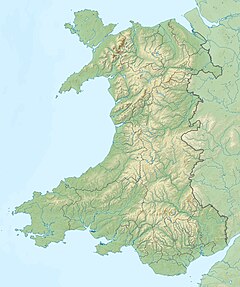
Back نهر تيفى ARZ Stêr Teifi Breton Riu Teifi Catalan Afon Teifi (suba) CEB Teifi Czech Afon Teifi Welsh Teifi (Fluss) German Teifi ibaia Basque Teifi French Teifi (fiume) Italian
| River Teifi | |
|---|---|
 Llyn Teifi, the source of the Teifi | |
| Native name | Afon Teifi (Welsh) |
| Location | |
| Country | Wales |
| Counties | Ceredigion, Carmarthenshire, Pembrokeshire |
| Physical characteristics | |
| Source | |
| • location | Llyn Teifi |
| • coordinates | 52°17′30″N 3°47′24″W / 52.2918°N 3.7900°W |
| • elevation | 455 m (1,493 ft) |
| Mouth | |
• location | Cardigan Bay |
• coordinates | 52°06′11″N 4°41′20″W / 52.103°N 4.689°W |
• elevation | 0 m (0 ft) |
| Length | 122 km (76 mi)[1] |
| Basin size | 1,008 km2 (389 sq mi)[2] |
| Discharge | |
| • location | Glan Teifi[3] |
| • average | 29.1 m3/s (1,030 cu ft/s)[3] |
| • maximum | 373.6 m3/s (13,190 cu ft/s) |
| Basin features | |
| Tributaries | |
| • left | Tyweli, Cych |
| • right | Dulas, Clettwr, Ceri |
The River Teifi (English: /ˈtaɪvi/; Welsh: Afon Teifi, pronounced [ˈavɔn ˈtei̯vi])[citation needed] in Wales forms the boundary for most of its length between the counties of Ceredigion and Carmarthenshire, and for the final 3 miles (4.8 km) of its total length of 76 miles (122 km), the boundary between Ceredigion and Pembrokeshire. Its estuary is northwest of Cardigan, known in Welsh as Aberteifi, meaning 'mouth of the Teifi'. Teifi has formerly been anglicised as "Tivy".[4][5]
- ^ "River Teifi". Countryside Council for Wales. Archived from the original on 21 February 2014. Retrieved 4 February 2014.
- ^ Cite error: The named reference
fwrswas invoked but never defined (see the help page). - ^ a b "62001-Teifi at Glanteifi". The National River Flow Archive. Centre for Ecology & Hydrology. Retrieved 4 February 2014.
- ^ "Felindre, River Tivy (Avon Teifi) c.1955". Francis Frith. Retrieved 10 August 2019.
- ^ "River Tivy". Bartleby.com. Retrieved 11 August 2019.
